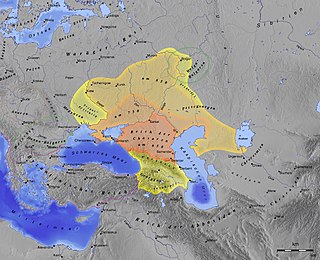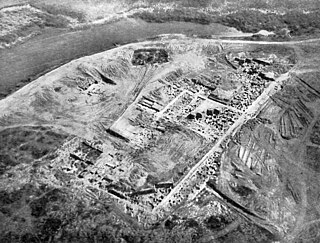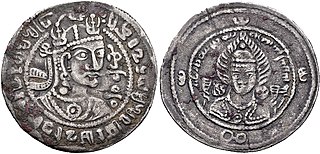Related Research Articles

The Khazars were a nomadic Turkic people that, in the late 6th-century CE, established a major commercial empire covering the southeastern section of modern European Russia, southern Ukraine, Crimea, and Kazakhstan. They created what for its duration was the most powerful polity to emerge from the break-up of the Western Turkic Khaganate. Astride a major artery of commerce between Eastern Europe and Southwestern Asia, Khazaria became one of the foremost trading empires of the early medieval world, commanding the western marches of the Silk Road and playing a key commercial role as a crossroad between China, the Middle East and Kievan Rus'. For some three centuries the Khazars dominated the vast area extending from the Volga-Don steppes to the eastern Crimea and the northern Caucasus.

Sarkel was a large limestone-and-brick fortress in what is now Rostov Oblast of Russia, on the left bank of the lower Don River.

The Turkic peoples are a collection of diverse ethnic groups of West, Central, East, and North Asia as well as parts of Europe, who speak Turkic languages.

Atil, also Itil, was the capital of the Khazar Khaganate from the mid-8th century to the late 10th century. It is known historically to have been situated along the Silk Road, on the northern coast of the Caspian Sea, in the Volga Delta region of modern Southern Russia. Its precise location has long been unknown.
Seljuk, variously romanized, was an Oghuz Turkic warlord. He was the eponymous founder of the Seljuk dynasty and the namesake of Selçuk, the modern town near the ruins of ancient Ephesus in Turkey.

The Yemek or Kimek were a Turkic tribe constituting the Kimek-Kipchak confederation, whose other six constituent tribes, according to Abu Said Gardizi, were the Imur, Tatars, Bayandur, Kipchaks, Lanikaz, and Ajlad.

The Kimek–Kipchak confederation was a medieval Turkic state formed by seven peoples, including the Yemeks and Kipchaks, in the area between the Ob and Irtysh rivers.

Yitzhak ha-Sangari was the rabbi who purportedly converted the Khazar royalty to Judaism, according to medieval Jewish sources. According to D. M. Dunlop, "the name Isaac Sangari is perhaps not attested before the 13th century when he is mentioned by Nahmanides."
Arsiyah was the name used for a group of Muslim mercenaries in the service of the Khazar Khaganate. Whether the Arsiyah were a single tribe or composed of Muslims from a number of different tribes is unclear. Also unclear is their origin; many historians regard them as deriving from Khwarazm, but some scholars point to the fact that "As" is the Turkic term for Alans and believe that the Arsiyah were Alanic in origin. Other scholars derive the name from the Iranian Auruša (white).
ʿAbd al-Raḥmān ibn Rabīʿa al-Bāhilī was an Arab general of the Rashidun Caliphate, who led the Arab forces during the First Arab–Khazar War, until his death in battle in 652.
According to ibn Fadlan, the Jāwashīghar was an official in the Khazar government under the command of the Kündür Khagan, in turn under Khagan Bek's command. Ibn Fadlan did not describe the duties of this officer.

An elteber was a client king of an autonomous but tributary tribe or polity in the hierarchy of the Turkic khaganates including Khazar Khaganate.
The Battle of Marj Ardabil or the Battle of Ardabil was fought on the plains surrounding the city of Ardabil in northwestern Iran in AD 730. A Khazar army led by Barjik, the son of the Khazar khagan, invaded the Umayyad provinces of Jibal and Iranian Azerbaijan in retaliation for Caliphate attacks on Khazaria during the course of the decades-long Khazar-Arab War of the early 8th century.
Alp Ilutuer was the Ilutuer of the North Caucasian Huns during the 680s CE.
Isaac ben Hanukkah was a hypothetical Jewish ruler of the Khazars mentioned in the Khazar Correspondence. He probably reigned in the mid to late ninth century CE. Little is known about his reign. As with other Bulanid rulers, it is unclear whether Isaac was Khagan or Khagan Bek of the Khazars, although the latter is more likely. He was succeeded by his son Zebulun. Historical authenticity and accuracy of the only document mentioning his name has been questioned.
The Turkic migrations were the spread of Turkic tribes and Turkic languages across Eurasia between the 4th and 11th centuries. In the 6th century, the Göktürks overthrew the Rouran Khaganate in what is now Mongolia and expanded in all directions, spreading Turkic culture throughout the Eurasian steppes. Although Göktürk empires came to an end in the 8th century, they were succeeded by numerous Turkic empires such as the Uyghur Khaganate, Kara-Khanid Khanate, Khazars, and the Cumans. Some Turks eventually settled down into sedentary societies such as the Qocho and Ganzhou Uyghurs. The Seljuq dynasty settled in Anatolia starting in the 11th century, resulting in permanent Turkic settlement and presence there. Modern nations with large Turkic populations include Kyrgyzstan, Turkmenistan, Turkey, Azerbaijan, Uzbekistan and Kazakhstan, and Turkic populations also exist within other nations, such as Chuvashia, Bashkortostan, Tatarstan and the Sakha Republic of Siberia in Russia, Northern Cyprus, the Crimean Tatars, the Kazakhs in Mongolia, the Uyghurs in China, and the Azeris in Iran.

The Toquz Oghuz was a political alliance of nine Turkic Tiele tribes in Inner Asia, during the early Middle Ages. The Toquz Oghuz was consolidated and subordinated within the First Turkic Khaganate (552–603) and remained as a nine-tribe alliance after the Khaganate fragmented.
Tong Yabghu Qaghan was khagan of the Western Turkic Khaganate from 618 to 628 AD. Tong Yanghu was the brother of Sheguy (r. 611–618), the previous khagan of the western Göktürks, and was a member of the Ashina clan; his reign is generally regarded as the zenith of the Western Göktürk Khaganate.

The Karluk Yabghu State was a polity ruled by Karluk tribes.

Turkic history is the systematic documentation and study of events involving the Turkic peoples.
References
- Douglas M. Dunlop, The History of the Jewish Khazars, Princeton, N.J.: Princeton University Press, 1954.
- ↑ Hirth, Friedrich (2021-06-17). China and the Roman Orient: Researches into their Ancient and Medieval Relations as Represented in Early Chinese Records. Bloomsbury Publishing. ISBN 978-0-7556-3939-7.


